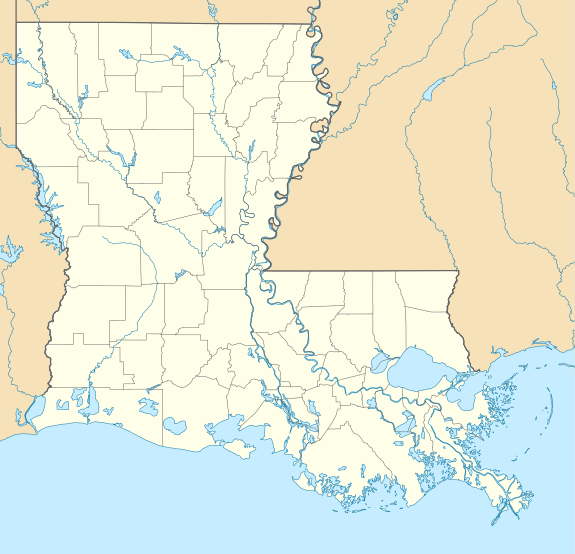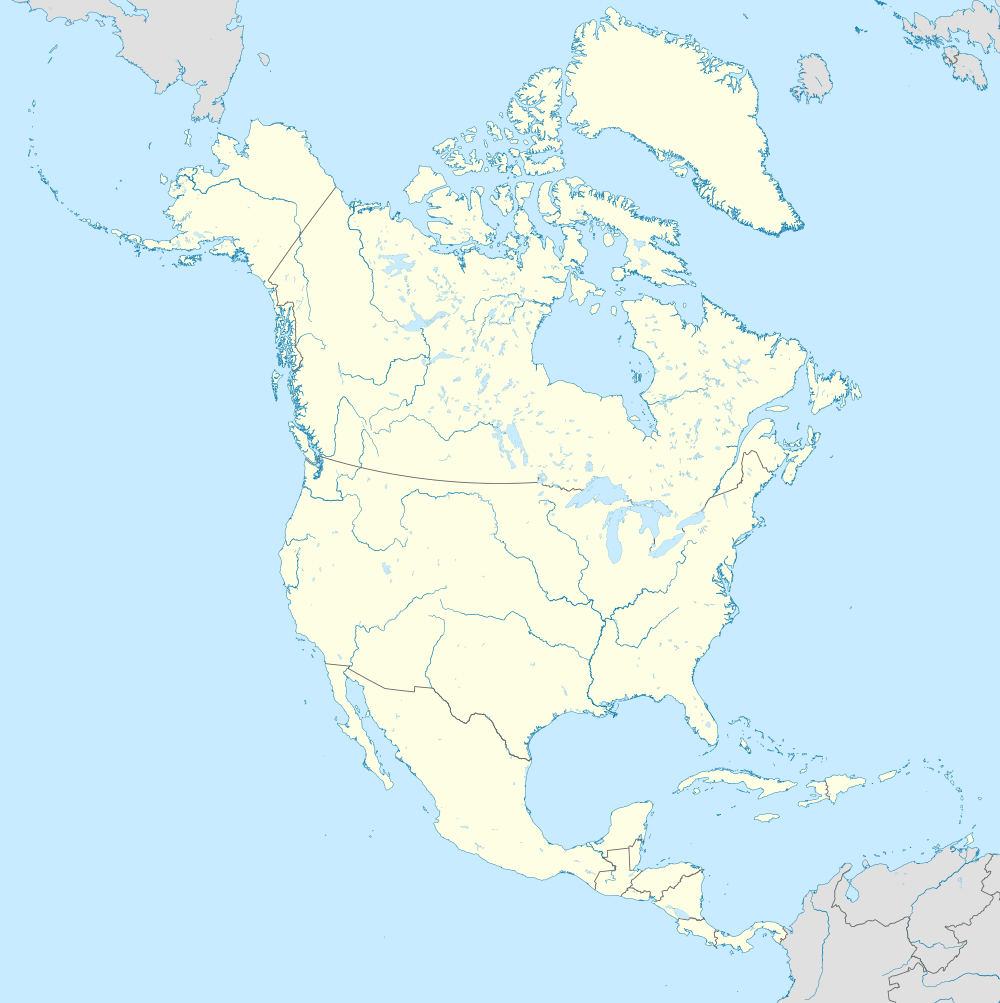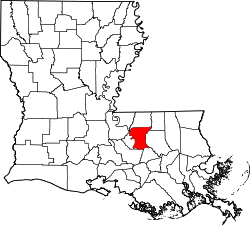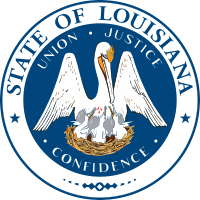Baker, Louisiana
Baker is a small city in East Baton Rouge Parish, Louisiana, United States, and a part of the Baton Rouge Metropolitan Statistical Area. It is the fourth-largest city in East Baton Rouge Parish. The population was 13,895 as of the 2010 census,[3] an increase of 102 persons from the 2000 tabulation of 13,793.
Baker | |
|---|---|
| City of Baker | |
 Location of Baker in East Baton Rouge Parish, Louisiana | |
 Baker Location of Louisiana in the United States  Baker Baker (the United States)  Baker Baker (North America) | |
| Coordinates: 30°35′08″N 91°09′26″W | |
| Country | |
| State | |
| Parish | East Baton Rouge |
| Government | |
| • Mayor | Darnell Waites (D) (elected April 10, 2016) |
| Area | |
| • Total | 8.40 sq mi (21.77 km2) |
| • Land | 8.40 sq mi (21.77 km2) |
| • Water | 0.00 sq mi (0.00 km2) |
| Population (2010) | |
| • Total | 13,895 |
| • Estimate (2019)[2] | 13,194 |
| • Density | 1,569.78/sq mi (606.09/km2) |
| Time zone | UTC-6 (CST) |
| • Summer (DST) | UTC-5 (CDT) |
| FIPS code | 22-03985 |
| Website | cityofbakerla |
History
Baker was named in 1888 for an early settler.[4]
Geography
Baker is located north of the center of East Baton Rouge Parish at 30°35′8″N 91°9′26″W (30.585637, -91.157096).[5] It is bordered to the north by Zachary and to the south by Baton Rouge. According to the United States Census Bureau, Baker has a total area of 8.3 square miles (21.5 km2), all land.[3]
Louisiana Highway 19 runs through the center of Baker, leading north 4 miles (6 km) to the center of Zachary and south 5 miles (8 km) to U.S. Route 61 in the northern part of Baton Rouge. Downtown Baton Rouge is 11 miles (18 km) south of Baker. Louisiana Highway 67 passes through the eastern part of Baker, leading north 22 miles (35 km) to Clinton and south 9 miles (14 km) into the center of Baton Rouge.
Demographics
| Historical population | |||
|---|---|---|---|
| Census | Pop. | %± | |
| 1950 | 762 | — | |
| 1960 | 4,823 | 532.9% | |
| 1970 | 8,281 | 71.7% | |
| 1980 | 12,865 | 55.4% | |
| 1990 | 13,233 | 2.9% | |
| 2000 | 13,793 | 4.2% | |
| 2010 | 13,895 | 0.7% | |
| Est. 2019 | 13,194 | [2] | −5.0% |
| U.S. Decennial Census[6] | |||
As of the census[7] of 2000, there were 13,793 people, 4,971 households, and 3,782 families residing in the city. The population density was 1,747.3 people per square mile (675.0/km2). There were 5,389 housing units at an average density of 682.7 per square mile (263.7/km2). The racial makeup of the city was 45.97% White, 52.36% African American, 0.28% Native American, 0.22% Asian, 0.01% Pacific Islander, 0.17% from other races, and 0.99% from two or more races. Hispanic or Latino people of any race were 0.86% of the population.
There were 4,971 households out of which 39.5% had children under the age of 18 living with them, 50.6% were married couples living together, 21.4% had a female householder with no husband present, and 23.9% were non-families. 20.6% of all households were made up of individuals and 6.7% had someone living alone who was 65 years of age or older. The average household size was 2.75 and the average family size was 3.18.
In the city, the population was 29.8% under the age of 18, 10.7% from 18 to 24, 28.5% from 25 to 44, 21.1% from 45 to 64, and 10.0% who were 65 years of age or older. The median age was 32 years. For every 100 females, there were 84.6 males. For every 100 females age 18 and over, there were 80.0 males. The median income for a household in the city was $35,151, and the median income for a family was $38,621. Males had a median income of $31,791 versus $22,177 for females. The per capita income for the city was $14,920. About 13.4% of families and 15.5% of the population were below the poverty line, including 23.5% of those under age 18 and 10.5% of those age 65 or over.
Baker received an influx of New Orleans residents during the immediate aftermath of Hurricanes Katrina and Rita. Renaissance Village (established by the Federal Emergency Management Agency) was the home to more than 3,000 evacuees, of whom more than 500 were school-age children. The large majority of the residents came from the poorest parts of New Orleans.
Government and infrastructure
The United States Postal Service operates the Baker Post Office.[8]
The Jetson Center for Youth, a former juvenile prison operated by the Louisiana Office of Juvenile Justice, is located near Baker in an unincorporated area.[9]
Baker Buffalo Festival
The Baker Buffalo Festival is held every year on the last full weekend in September. The festival was started in 1993 as a fundraiser for the schools in Baker. The schools and their organizations use the festival to raise money for their activities. The Festival Committee also makes donations to all the schools that participate. The event includes a festival, parade, Queen's pageant, and car show.
Education
Baker residents are zoned to the City of Baker School System. Baker High School is the city's high school.
Unincorporated areas with Baker addresses are within the East Baton Rouge Parish Public Schools.
East Baton Rouge Parish Library operates the Baker Branch, located across from Baker High School. The library opened in Miss Angie Williams' Tea Room on June 19, 1941 and subsequently moved to a school building in 1955, a third building building, and then the Baker Masonic Lodge on July 20, 1959. The current library, with 17,900 square feet (1,660 m2) of space, opened in April 2001; it was designed by Cockfield-Jackson Architects.[10]
National Guard
Baker is home to the 926th MAC (mobility augmentation company) which is part of the 769th Engineer Battalion (combat) headquartered in Baton Rouge. These units belong to the 225th Engineer Brigade which is headquartered at Pineville on Camp Beauregard. As of 2011 this unit has been activated for overseas deployment to a combat theater.
Notable people
- Ossie Brown, East Baton Rouge Parish district attorney 1972–1984; grew up in Baker and graduated from Baker High School[11]
- Barbara West Carpenter, dean of international relations at Southern University; District 63 state representative for East Baton Rouge Parish; resides in Baker[12]
- Mike Cross, politician, mayor of Baker 1976–1981
- Don Lemon, author and journalist graduated from Baker High School (Don Lemon)
- Rufus D. Hayes, first Louisiana insurance commissioner; East Baton Rouge Parish district attorney and judge; resided in Baker at the time of his death in 2002
- Norman E. "Pete" Heine, served terms as mayor of the city both before and after Mike Cross
- Jim Mitchell, 1964 Baker High School alumnus; judge of the Louisiana 30th Judicial District Court in Leesville from 2009 until his death in 2015[13]
- Tony Perkins, politician and Republican former Louisiana State Representative; resided in Baker until he relocated to Washington, D.C., to head the Family Research Council
- Bobby Simpson, a Republican, became the East Baton Rouge mayor-president in 2001
- Linda Thomas-Greenfield, has had a career in the Foreign Service and was Assistant Secretary of State for African Affairs; born in Baker[14]
Twin cities
| Flag | City | Country |
|---|---|---|
| Joal-Fadiouth | Senegal |
References
- "2019 U.S. Gazetteer Files". United States Census Bureau. Retrieved July 25, 2020.
- "Population and Housing Unit Estimates". United States Census Bureau. May 24, 2020. Retrieved May 27, 2020.
- "Geographic Identifiers: 2010 Demographic Profile Data (G001): Baker city, Louisiana". American Factfinder. U.S. Census Bureau. Archived from the original on February 13, 2020. Retrieved February 2, 2016.
- Leeper, Clare D'Artois (19 October 2012). Louisiana Place Names: Popular, Unusual, and Forgotten Stories of Towns, Cities, Plantations, Bayous, and Even Some Cemeteries. LSU Press. p. 27. ISBN 978-0-8071-4740-5.
- "US Gazetteer files: 2010, 2000, and 1990". United States Census Bureau. 2011-02-12. Retrieved 2011-04-23.
- "Census of Population and Housing". Census.gov. Retrieved June 4, 2015.
- "U.S. Census website". United States Census Bureau. Retrieved 2008-01-31.
- "Baker." U.S. Postal Service. Retrieved on January 7, 2017. "3009 RAY WEILAND DR BAKER, LA 70714-9998"
- "Jetson Center for Youth." Office of Juvenile Justice. Retrieved on June 30, 2010. "15200 Old Scenic Highway (at US Hwy 61) Baker, LA 70714 (physical address) "
- "Baker Branch Library." East Baton Rouge Parish Library. Retrieved on January 7, 2017. "Baker Branch Library 3501 Groom Rd., Baker, LA 70714"
- http://www.legacy.com/theadvocate/DeathNotices.asp?Page=Lifestory&PersonId=116574977
- Andrea Gallo, "Barbara West Carpenter defeats Ulysses “Bones” Addison in race for House District 63 seat", The Advocate, 23 November 2015
- "Obituary: Judge James "Jim" Mitchell". Leesville Daily Leader. Retrieved July 26, 2015.
- "Linda Thomas-Greenfield, Assistant Secretary, Bureau of African Affairs". U.S. Department of State. Retrieved 2015-03-29.

